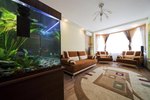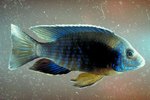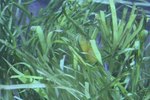
Different cichlid species come from all over the world. Individual cichlid species have different requirements in terms of water chemistry. However, aquarium hobbyists generally group cichlids according to their home ranges, since cichlids from the same areas generally have similar water chemistry requirements and compatible behaviors.
African Cichlids
When an aquarium hobbyist says "African cichlid," it's understood to mean a cichlid from the African Great Lakes in the Rift Valley. The majority of the continent's cichlids come from these lakes and have similar temperaments. African cichlids prefer hard, alkaline water. Most are very aggressive, but in a large tank, dissimilar-patterned species can get along. You do want to avoid keeping closely related species together, since they may produce undesirable hybrids. For example, no two Auloncara species should share an aquarium. But you can keep an Auloncara with utaka and mbuna cichlds from this lake in the same aquarium.
Dwarf Cichlids
Dwarf cichlids come from the rainforest rivers of South American and western Africa. Despite their geographic differences, these fish tend to get along well and require similar water chemistry. This includes fish like the ram, krib, and the apsitos. These cichlids prefer soft, acidic water. Their small size allows you to keep these species in smaller aquariums comfortably.
Larger River Cichlids
South America also houses several larger river cichlids. These species will often get along well in aquariums. For example, various species of freshwater angelfish and the discus fish make great tank mates. Both species prefer soft, acidic water and, importantly, grow to about the same size. Unlike most aquarium fish, both angelfish and discus need a taller aquarium to accommodate their tall bodies.
Central American Cichlids
Central America cichlids prefer water chemistry similar to that of African cichlids, but the two groups of fish should not share an aquarium, due to behavioral issues. In fact, many cichlids from this region have a hard time sharing an aquarium. Male-female pairs usually work out OK, but more than a pair is dicey. If you want to keep more than a pair of cichlids from Central America, you need an aquarium of at least 260 gallons, with lots of hiding places to diffuse aggression.
References
- FishChannel.com: Cichlid Fish Information
- Tropical Fish Hobbyist: Aquarium Basics: Aquarium Setup Guide
- Seriously Fish: Amphilophus labiatus
- FishChannel.com: Cichlids of the Americas - Angelfish
- FishChannel.com: Angelfish and Discus: Hard Water or Soft Water?
- Aquatic Community: Aulonocara
- Aquatic Community: Haplochromis
Photo Credits
-
Jupiterimages/Photos.com/Getty Images




